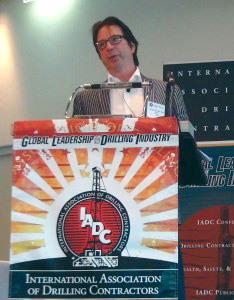Subsea Well Response Project intervention system nears completion
By Linda Hsieh, managing editor

The first equipment under development with the Subsea Well Response Project (SWRP) – which includes four capping stack toolboxes and two subsea dispersant hardware kits – are due to be completed by the end of this year and become available to the industry, said Klaas van der Plas, principal well engineer cap and containment, Subsea Well Response Project, A/S Norske Shell, at the 2012 IADC Drilling HSE Europe Conference in Amsterdam on 26 September. “I think that will be a milestone for the industry. While we hope that this intervention equipment is never needed, it’s critical for the industry to be prepared,” he said.
Created in 2011 under a recommendation by the OGP, the SWRP is a not-for-profit initiative set up by nine major oil and gas companies with the goal of enhancing industry’s global capacity to respond to subsea well incidents. The group set out specifically to design a capping toolbox that would allow subsea wells to be shut in, to design hardware for the subsea injection of dispersants, to evaluate their deployment options, and to assess the need and feasibility for a containment system in the event the capping operation cannot immediately control the well.
Mr van der Plas noted that a theme of collaboration underpinned all of SWRP’s activities since the beginning, as the effort spanned across the industry under OGP’s Global Incident Response Group. SWRP collaborated closely with both OGP’s Wells Expert Committee, whose work primarily focuses on prevention, and a joint industry project on oil spill response led by IPIECA. “This extensive collaboration has helped us plan new well intervention equipment that we believe will enhance capabilities to respond effectively to a subsea incident,” Mr van der Plas said.
The SWRP’s subsea well intervention system is made up of four capping stack toolboxes and two subsea dispersant hardware kits that will be available for the majority of subsea wells around the world. Two of the capping stacks are 15,000-psi, 18 ¾-in. full-bore systems, and two are 10,000-psi, 7 1/16-in. reduced-bore systems. However, Mr van der Plas notes that all four capping systems are standardized, designed from a common core structure for greater component compatibility and flexibility.
The equipment has been designed for subsea wells in water depths up to 3,000 meters and rated for up to 150° C, and there are four subsea chokes to facilitate the closing procedures, all operated by ROVs. “And the subsea accumulators are subsea-rechargeable and can be deployed either assembled or disassembled,” he added. Further, SWRP is working with DNV to obtain a certificate of fitness for service.
Once completed, the subsea well intervention system will be handed over to Oil Spill Response Ltd (OSRL) to keep. The equipment will be stored in four strategic locations around the world in Northern Europe, South America, Africa and Asia Pacific. “One of SWRP’s key objectives is to get this equipment made available to the industry,” Mr van der Plas said. “Companies across the industry have this opportunity to access this equipment to membership with OSRL.”




